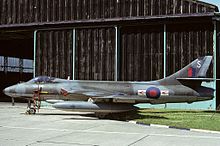Alan Pollock

Hawker Hunter of the type used. Flight Lieutenant Alan Pollock was the first person to fly a jet aircraft under the upper span of Tower Bridge.
|
|
| summary | |
|---|---|
| Date | 5 April 1968 |
| Summary | Aircraft flew under bridge |
| Site |
Tower Bridge, London 51°30′20″N 0°04′32″W / 51.50556°N 0.07556°WCoordinates: 51°30′20″N 0°04′32″W / 51.50556°N 0.07556°W |
| Crew | 1 |
| Injuries (non-fatal) | 0 |
| Survivors | 1 |
| Aircraft type | Hawker Hunter FGA.9 |
| Operator | 1 Squadron, Royal Air Force |
| Registration | XF442 |
| Flight origin | RAF Tangmere, West Sussex |
| Destination | RAF West Raynham, Norfolk |
The Hawker Hunter Tower Bridge incident occurred on 5 April 1968 when Royal Air Force (RAF) Hawker Hunter pilot Alan Pollock performed unauthorised low flying over several London landmarks and then flew through the span of Tower Bridge on the Thames. His actions were to mark the 50th anniversary of the founding of the RAF and as a demonstration against the Ministry of Defence (Air) for not recognising it.
Upon landing he was arrested and later invalided out of the RAF on medical grounds which avoided a court martial.
In the 1960s, the British defence industry saw a shifting emphasis from manned aircraft towards guided missiles, originating from the 1957 Defence White Paper by British Defence Minister Duncan Sandys. The British aircraft industry had slipped into general decline and morale in the aerial services of the British armed forces was low. Flight Lieutenant Alan Pollock, a flight commander in No. 1 (Fighter) Squadron RAF, was further displeased that no aerial displays had been planned to mark the RAF's 50th anniversary.
On 1 April 1968, Pollock and other members of No. 1 Squadron took part in anniversary leaflet raids on other RAF stations and on 4 April visited RAF Tangmere, where they performed a display.
On 5 April 1968 Pollock decided on his own initiative to mark the occasion of the RAF anniversary with an unauthorised display. His flight left the soon-to-be-closed RAF Tangmere in Sussex to return to RAF West Raynham in Norfolk, a route that took them over London. Immediately after takeoff, Pollock left the flight and flew low level. Having "beaten up"Dunsfold Aerodrome (Hawker's home airfield), he then took his Hawker Hunter FGA.9 (XF442), a single-seater, ground-attack jet fighter, over London at low level, circled the Houses of Parliament three times as a demonstration against Prime Minister Harold Wilson's government, dipped his wings over the Royal Air Force Memorial on the Embankment and finally flew under the top span of Tower Bridge. He later wrote of the decision to fly through Tower Bridge:
...
Wikipedia
